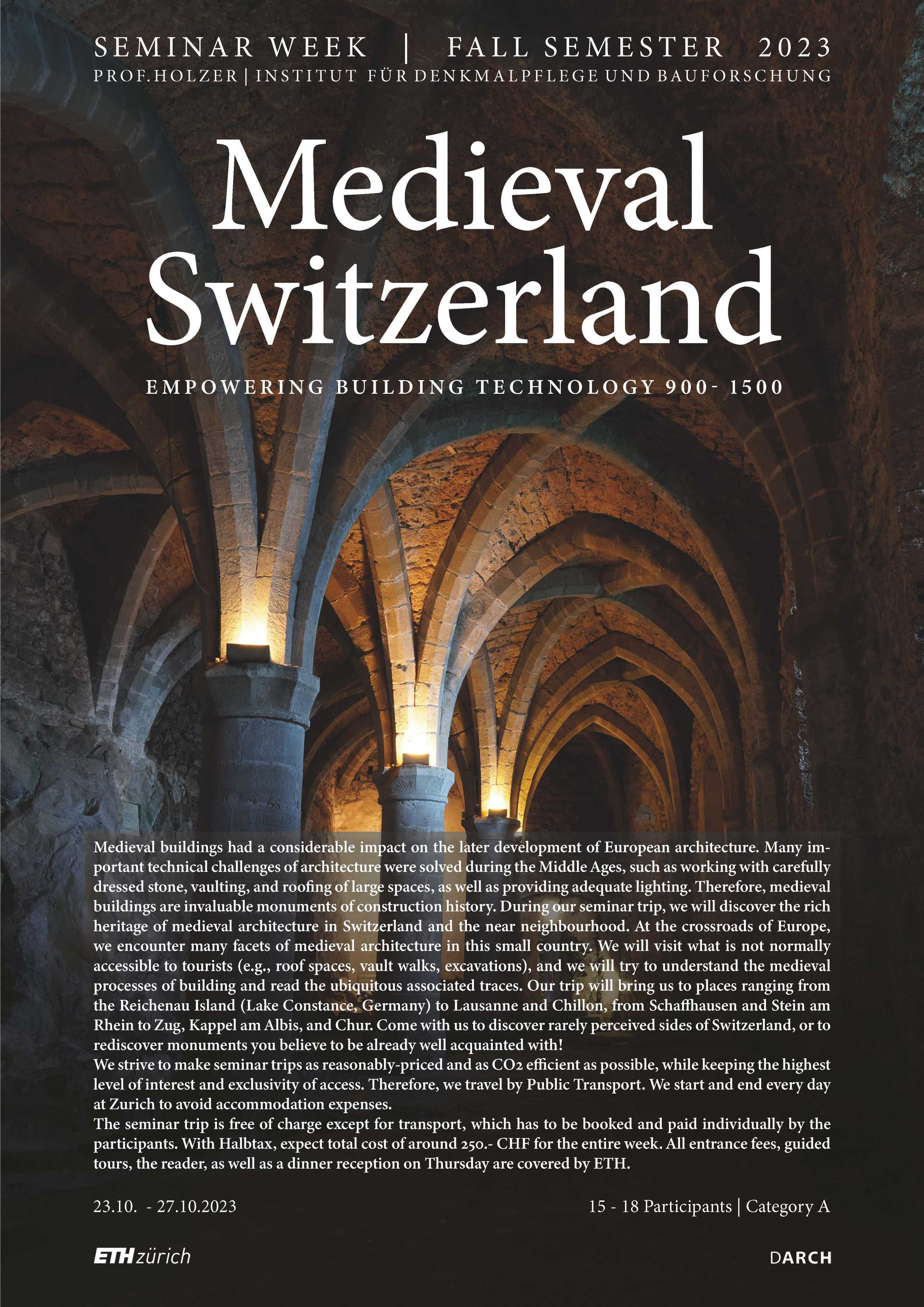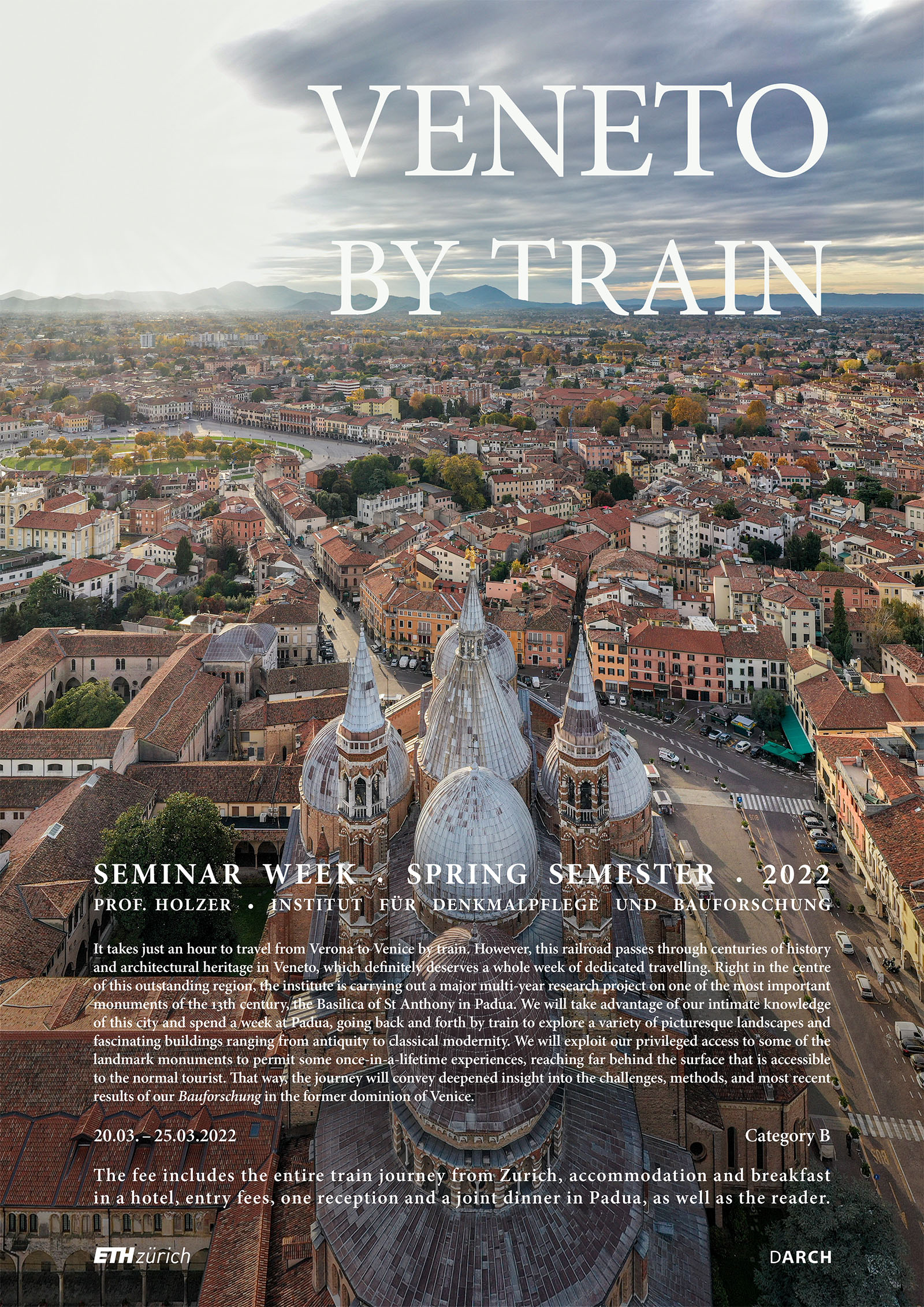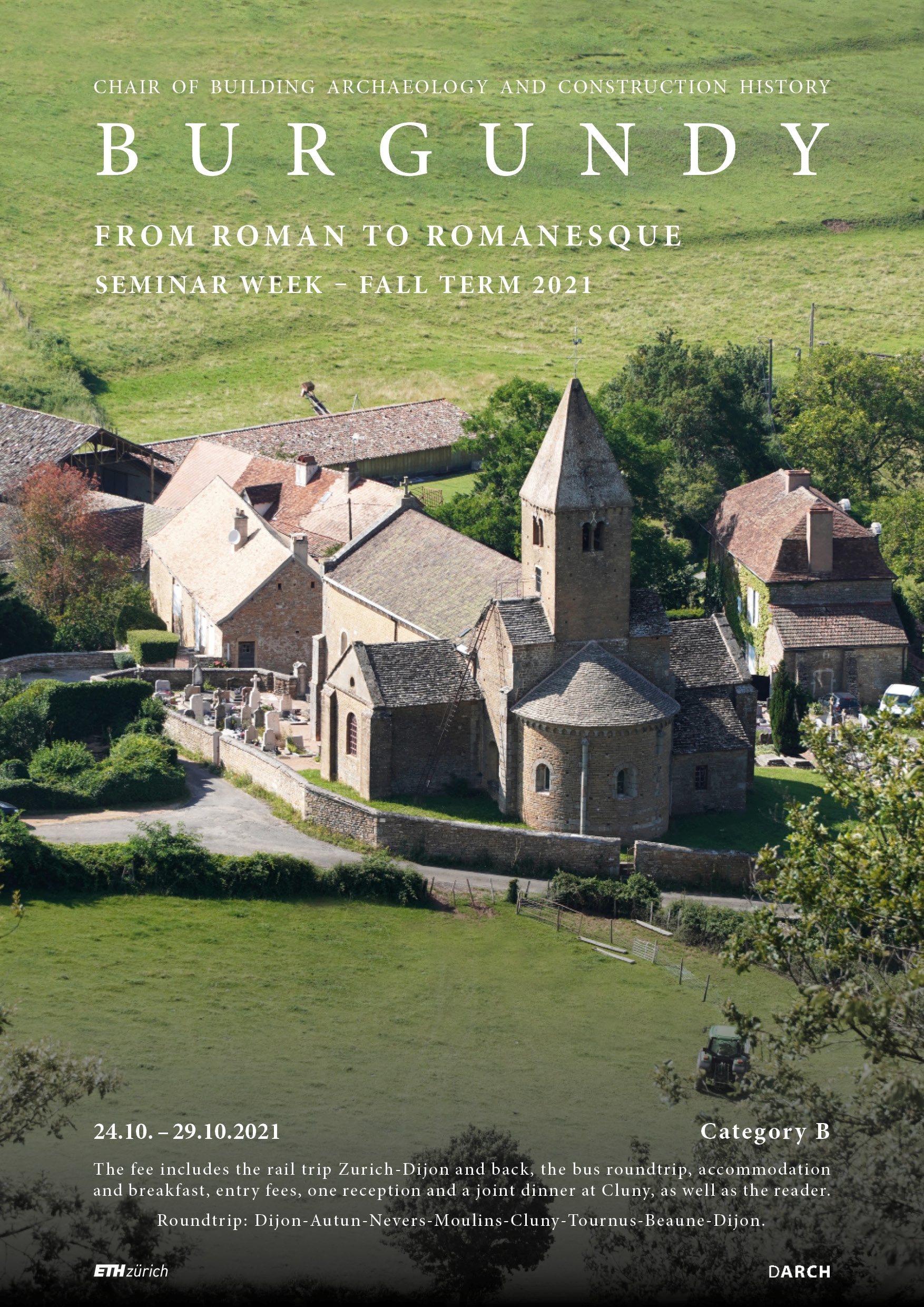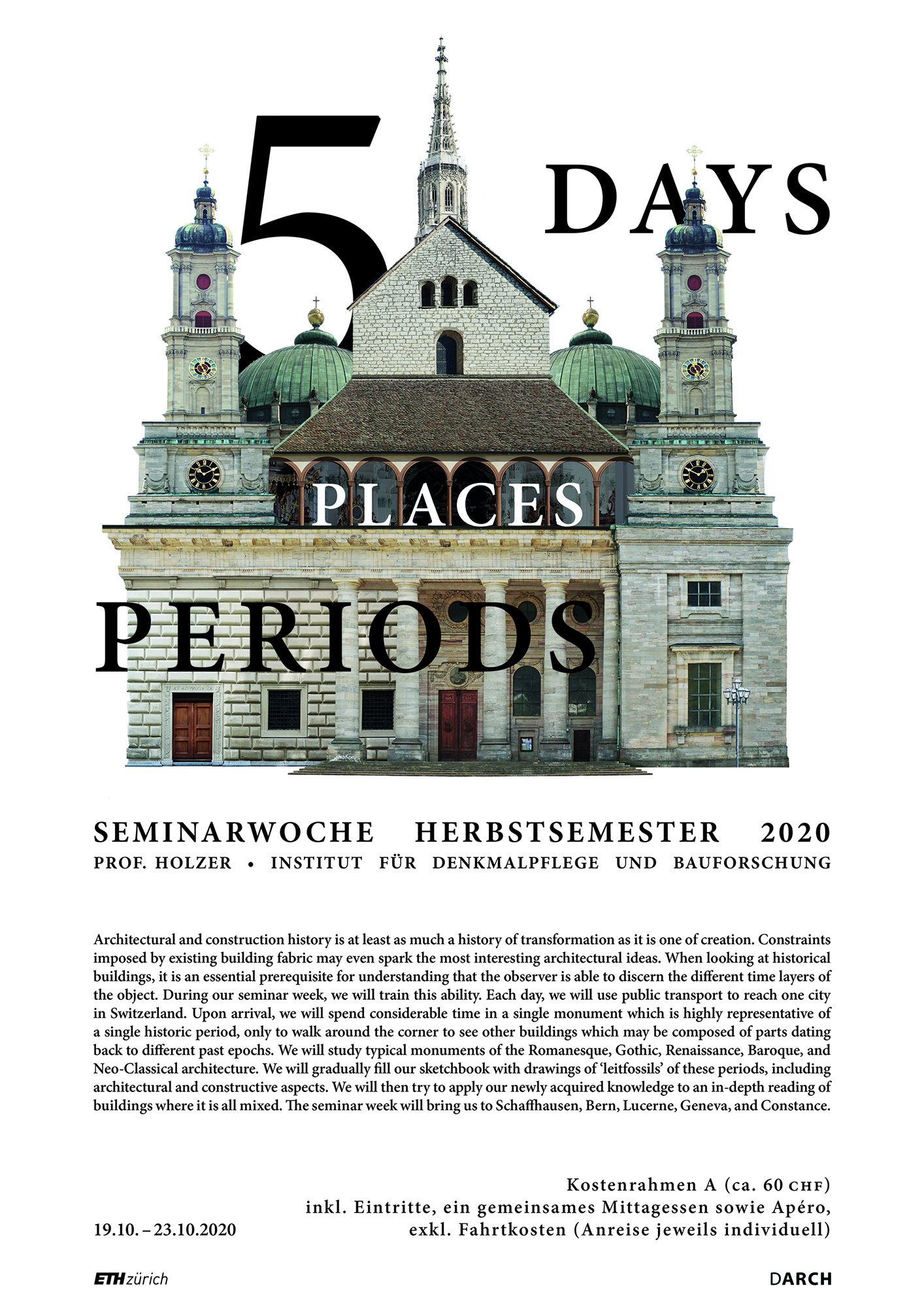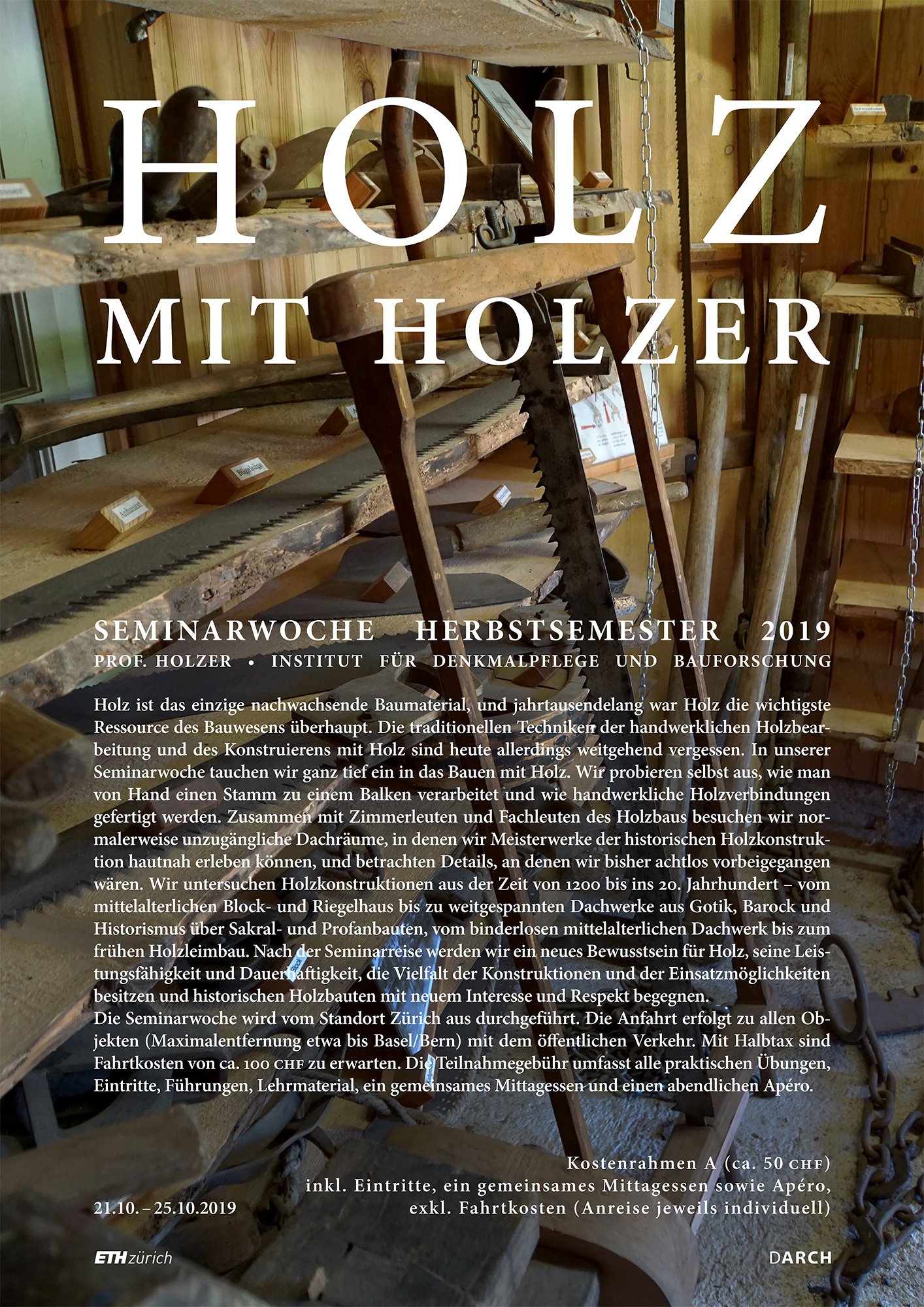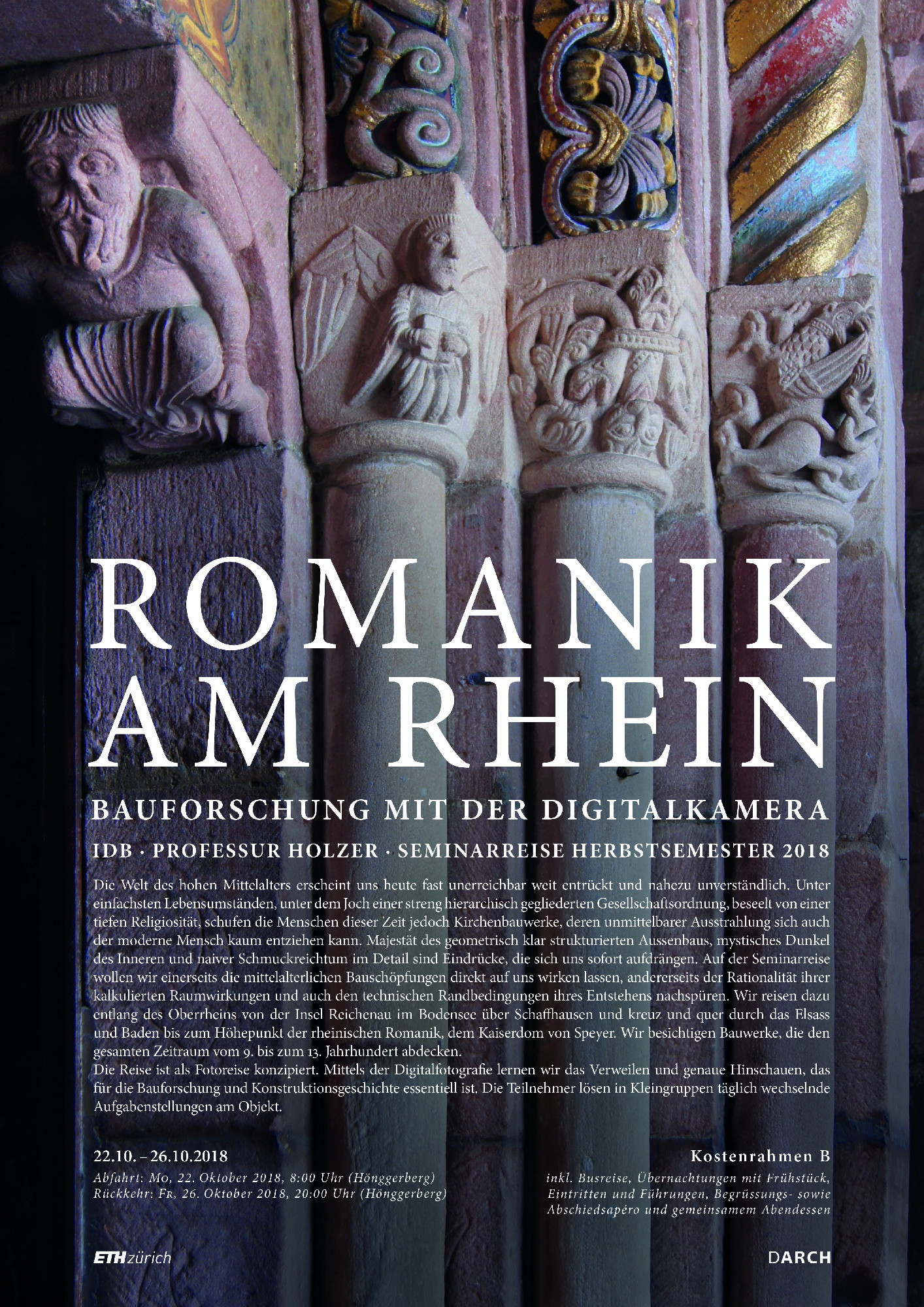Past Seminar-Weeks

Campania – the region around Naples – abounds in architectural traces of an infinitely rich past ranging from Greek antiquity to modern times. We will establish ourselves for a week in Naples and explore the city and its scenic environs on the seaside below Mount Vesuvius, by public transport. Visits will not just show us famous highlights such as the temples of Paestum, Pompei and the Royal Palace of Caserta, but also less known, but particularly interesting buildings covering almost all the centuries from Paestum up to today. Local experts will permit us to look behind the touristic facades and learn details about the building history and construction of some of the most important monuments. We will travel from Zurich to Naples and back by train. A reception and a dinner will also permit us to get to know the typical local food and enjoy the inspiring atmosphere of legendary Naples.
23. - 29.10.2022 · Category C
The fee includes the entire train journey from Zurich, accommodation and breakfast in a hotel, entry fees, one reception and a joint dinner in Naples, as well as the reader.
It takes just an hour to travel from Verona to Venice by train. However, this railroad passes through centuries of history and architectural heritage in Veneto, which definitely deserves a whole week of dedicated travelling. Right in the centre of this outstanding region, the institute is carrying out a major multi-year research project on one of the most important monuments of the 13th century, the Basilica of St Anthony in Padua. We will take advantage of our intimate knowledge of this city and spend a week at Padua, going back and forth by train to explore a variety of picturesque landscapes and fascinating buildings ranging from antiquity to classical modernity. We will exploit our privileged access to some of the landmark monuments to permit some once-in-a-lifetime experiences, reaching far behind the surface that is accessible to the normal tourist. That way, the journey will convey deepened insight into the challenges, methods, and most recent results of our Bauforschung in the former dominion of Venice.
20. – 25.03.2022 · Category B
The fee includes the entire train journey from Zurich, accommodation and breakfast, entry fees, one reception and a joint dinner in Padua, as well as the reader.
The ancient Roman paradigm has left indelible marks on almost all posterior European architecture. This can be exemplified by the so-called “Romanesque” architecture, which reached particular rank in Burgundy, the heart of Europe. We will visit the ancient Roman monuments of Autun, and trace the influences of Roman precedents on medieval architecture in the region, particularly in masonry construction, stoneworking, and vaulting. The trip brings us to wonderful landscapes, small cities rich in history and monuments. The round-trip starts at Dijon, brings us via Autun to Nevers, then on to Moulins, Paray-le-Monial, Cluny, and Tournus, whose 11th century basilica has recently been surveyed by the institute. We return to Dijon via Beaune, the centre of the famous wine-producing region of Côte-d'Or.
24. – 29.10.2021 · Category B
The fee includes the rail trip Zurich-Dijon and back, the bus roundtrip, accommodation and breakfast, entry fees, one reception and a joint dinner at Cluny, as well as the reader.
Architectural and construction history is at least as much a history of transformation as it is one of creation. Constraints imposed by existing building fabric may even spark the most interesting architectural ideas. When looking at historical buildings, it is an essential prerequisite for understanding that the observer is able to discern the different time layers of the object. During our seminar week, we will train this ability. Each day, we will use public transport to reach one city in Switzerland. Upon arrival, we will typically spend considerable time in a single monument which is highly representative of a single historic period, only to walk around the corner to see other buildings which may be composed of parts dating back to considerably different past epochs. We will study typical monuments of the Romanesque, Gothic, Renaissance, Baroque, and Neo-Classical architecture. We will gradually fill our sketchbook with drawings of ‘leitfossils‘ of these periods, including architectural and constructive aspects. We will then try to apply our newly acquired knowledge to an in-depth reading of buildings where it is all mixed. The seminar week will bring us to Schaffhausen, Berne, Lucerne, Geneva, and Constance.
19. – 23.10.2020 · Cost Level A
Cost: 60 CHF approx., excluding public transport (to be payed individually)
Incl. entrance fees, one joint dinner and aperitif
Excl. travel expenses (individual arrival)
Timber is the only renewable building material, and for thousands of years timber has been the most important resource of the building industry. However, the traditional techniques of handicraft woodworking and construction with timber are largely forgotten today. In our seminar week we dive deep into building with timber. We will try out for ourselves how a log can be turned into a beam by hand and how handcrafted wood joints are made. Together with carpenters and wood construction experts, we normally visit inaccessible attics where we can experience masterpieces of historical timber construction up close, and look at details that we would have neglected so far. We examine timber constructions from the period 1200 to the 20th century - from medieval log houses and timber-framed houses to wide-span roof structures from Gothic, Baroque and Historicism, sacral and secular buildings, from binderless medieval roof structures to early glued timber structures. After the seminar trip we will have a new awareness for wood, its performance and durability, the variety of constructions and possible uses and we will treat historical wooden buildings with new interest and respect.
21. – 25.10.2019 · Cost Level A (around CHF 50.-)
The seminar week will be held in Zurich. All objects (maximum distance to Basel/Bern) will be accessible by public transport. With a Half-Fare travelcard, travel costs of approx. CHF 100 can be expected. The participation fee includes all practical exercises, admissions, guided tours, teaching material, a joint lunch and an evening aperitif.
Building research with the digital camera
The world of the High Middle Ages seems to us today almost unattainably far away and almost incomprehensible. Under the simplest living conditions, under the yoke of a strictly hierarchically structured social order, inspired by a deep religiosity, however, the people of this time created church buildings whose direct charisma even modern man can hardly escape. The majesty of the geometrically clearly structured exterior, the mystical darkness of the interior and the naive richness of jewellery in detail are impressions that impose themselves on us immediately. On the seminar trip we want to let the medieval building creations have a direct effect on us on the one hand, on the other hand we want to trace the rationality of their calculated spatial effects and also the technical boundary conditions of their emergence. We travel along the Upper Rhine from the island of Reichenau in Lake Constance via Schaffhausen and criss-cross through Alsace and Baden to the climax of the Rhenish Romanesque, the imperial cathedral of Speyer. We visit buildings covering the entire period from the 9th to the 13th century.
The trip is intended as a photo journey. By means of digital photography we learn to linger and take a closer look, which is essential for building research and construction history. The participants solve daily changing tasks in small groups.
22.10. – 26.10.2018 · Cost Level B
The participation fee includes the bus trip, overnight stays with breakfast, guided tours and entrance fees, welcome and closing aperitif and dinner together.

Seminar week: Burgundy, 19–23 March 2018
Our seminar excursion takes us to a landscape in the middle of France, known not only for its red wine, but also for its outstanding medieval monuments. In the format of the IDB's seminar trips, we will learn to see the perhaps already familiar monuments with new eyes - made possible by excursions behind the scenes and the resulting new perspectives. Starting from the old ducal town of Dijon, we travel to the Cistercian abbey of Fontenay, which is a UNESCO World Heritage Site, make a one-day detour to the glass painting metropolis of Troyes (Champagne), from there to Auxerre and Vézelay with its pilgrimage basilica, which is also distinguished by the UNESCO seal of approval, and back to Dijon. In addition to the Gothic cathedrals, we also see the wooden vaults of Fontenay and Tonnerre, we appreciate the restoration work by Viollet-le-Duc and get to know the earliest beginnings of concrete construction in Vassy-lès-Avallon and the Canal de Bourgogne (around 1830). Our journey therefore covers a wide range of different buildings from the 8th to the late 19th century.
Cost level B
The participation fee includes the arrival and departure via Dijon by train, the bus tour, overnight stays with breakfast, entrance fees, an aperitif, a joint dinner and the reader.
Prof. Dr.-Ing. Stefan M. Holzer

Seminar week: Southern Germany, 23–27 October 2017
Architecture is space. Large room heights and large spans have always posed special technical challenges for construction workers. In our seminar-week we look behind the facades and shells of important historical buildings to learn more about the constructive solutions of these monuments. On the way from the foundation to the attic we see hidden stairs and walkways, we walk over the vault and visit the roof constructions. We see how the building itself was used as its own scaffolding for the historical building. We recognize wall cross-sections and stone processing. At the cathedrals and monasteries of Konstanz, Maulbronn, Ulm, Regensburg and Ingolstadt we follow the development of roof constructions and vaults from the 12th to the 19th century. For each building, we are led by internationally renowned experts who have worked intensively on the building and its history. Our small group gets exclusive access to areas that are often closed even to researchers, such as roofs, triforia and galleries.
Cost level B (including transports, accommodation, apéro, and joint dinner).
Prof. Dr. Stefan M. Holzer

Seminar week: Sicily, 18–24 March 2017
Sicily is an island where the most diverse cultures of Europe and the neighbouring Mediterranean have left their architectural mark, from the first Greek colonists to the Arabs and Normans to the Spaniards and Italians. Above all, our journey takes us through the manufacturing technology and construction of historical buildings into consideration. At the ancient Greek temples of Segesta, Selinunt and Agrigento we will follow the working process from the quarrying of the stone in the quarry to the final stages of the construction itself. We experience first-hand how the settlements and monuments are embedded in the rich and flourishing Sicilian landscape. City complexes from the ancient Greek Selinunt to the Palermo of the Baroque and early 20th century can be experienced, materials from antique coloured marble foils to baroque stucco are within reach.
We are guided by Dr. Clemens Voigts (Munich), a proven expert in ancient Western Greece, and by Sicilian scientists. On site we want to take a lot of time to take a closer look, photograph and draw.
The journey begins on Saturday, March 18 at noon with the flight from Zurich to Palermo and leads us first for three nights in the Sicilian capital, then for three nights to Selinunt with a day trip to Agrigent. On Friday, 24 March, we return to Zurich late at night. Flights, bus tours and hotel accommodation with breakfast are included in the price. In order to have a detailed opportunity for an exchange, we will almost always have dinner (included) together in typical restaurants.
Cost level D (including transports, accommodation, and partly the meals).
Prof. Dr. Stefan M. Holzer

Seminar week: Paris, 24–28 October 2016
Paris ideally represents the development of the modern city during the 19th century. The expansion of the French metropolis organized itself along infrastructural axes such as canals, railways, and of course the famous boulevards. The 19th century has set the principal parameters which dominate the city’s urban fabric until today.
19th century France was the leading country in the engineering and building-related sciences. Consequently, experimental structures in cast iron, steel, concrete and other innovative materials abound. Many of these structures are still preserved and constitute important landmarks of construction history. Today, some of them pose serious issues of conservation which we will consider during our visits.
The excursion is organized in co-operation with the city’s preservation agency and other partners. We will visit numerous places normally inaccessible to the public, notably several roof spaces, permitting insight into hidden constructional features of the monuments considered.
Cost level C (including transports and accommodation).
Prof. Dr. Stefan M. Holzer, Valentin Gillet, Dr. Arnd Hennemeyer

